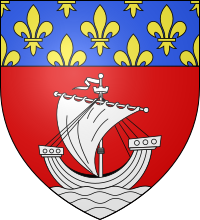Count of Paris

Count of Paris (French: Comte de Paris) was a title for the local magnate of the district around Paris in Carolingian times. After Hugh Capet was elected King of France in 987, the title merged into the crown and fell into disuse. However, it was later revived by the Orléanist pretenders to the French throne in an attempt to evoke the legacy of Capet and his dynasty, and is currently used by Prince Henri, Count of Paris, Duke of France.
Guideschi
- Bodilon
- Saint Warinus till 678
Pippinids
- Grifo (751-753), son of Charles Martel and his second wife, Swanahild
Girardids
- Gerard I (752-778)
- Stephen (778-811), son of previous
- Beggo (or Begon) (815-816), brother of previous
- Leuthard I of Paris (816), brother of Beggo and also count of Fézensac
- Gerard II (816), son of previous and brother of Adalard the Seneschal, also duke of Viennois
- Leuthard II of Paris (from 816), son of Beggo
- Adalard (877), count palatine, father of Adelaide, wife of Louis II of France
Welfs
- Conrad (858-859)
Robertians
- Odo, also king of France (until 888)
- Robert, also count of Blois, Anjou, Tours, and Orléans, margrave of Neustria, and king of France (888-923)
- Hugh the Great (923-956)
- Hugh Capet (956-996)
Bouchardids
- Bouchard I the Venerable (1005), also count of Vendôme, Corbeil, and Melun
- Reginald, also bishop of Paris
Orléanists
In 1838, during the July Monarchy, King Louis-Philippe I recreated the title for his newly born grandson Philippe.[1] After the Louis-Philippe abdicated during the French Revolution of 1848, Orléanist monarchists have considered Philippe and his descendants the legitimate heir to the throne. In 1870, at the beginning of the French Third Republic, Philippe and the Orléanists agreed to support the legitimist pretender, Henri, Count of Chambord, but resumed Philippe's claims after Henri's death in 1883.
- Prince Philippe, Count of Paris (1838-1894)
- Henri, Count of Paris (1908-1999)
- Henri d'Orléans, Count of Paris (born 1933)
See also
References
- ^ Le marquis de Flers (1889). Le comte de Paris. Translated by Constance Majendie. London: W. H. Allen & Co. p. 6.
